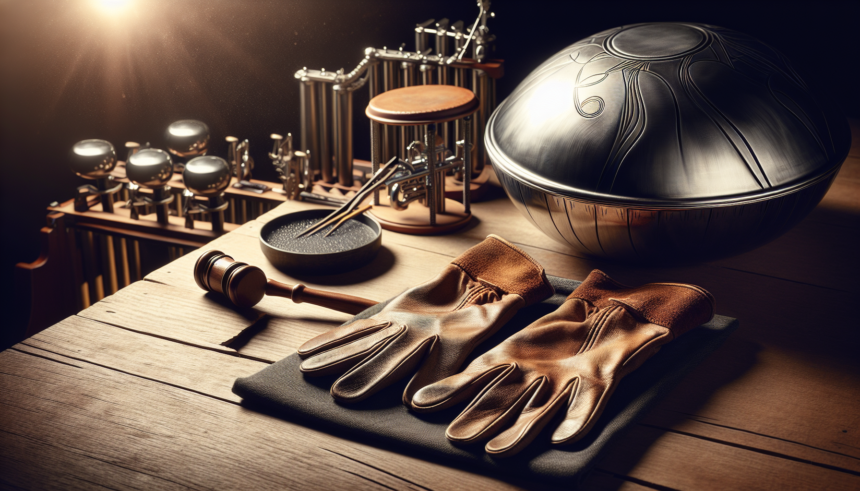The handpan is a unique and exquisite musical instrument that combines the qualities of a drum with those of a melodic instrument. Originating in Switzerland in the early 2000s, the handpan has since captivated musicians and enthusiasts alike. As a significant investment, maintaining its pristine condition is essential. One effective tool in preserving your handpan’s integrity is the use of handpan gloves. These gloves are specially designed to protect both the instrument and the player, ensuring the longevity and quality of the handpan’s sound.
The Importance of Handpan Maintenance
Handpans, typically fashioned from high-quality steel, require meticulous care to maintain their unique acoustic properties. Given the instrument’s surface is highly susceptible to moisture, oils, and dirt, proper handling and routine maintenance are vital. Neglecting these aspects can lead to rust, corrosion, and deterioration of sound quality. Therefore, understanding the importance of handpan maintenance is the first step in preserving your instrument.
Understanding Handpan Gloves
Handpan gloves are a practical and efficient solution to mitigate the risk of damage caused by direct contact. These gloves are usually made from materials like cotton, microfiber, or other non-abrasive fabrics that are gentle on the handpan’s surface. They are specifically designed to provide a balance between protection and playability, ensuring the player can comfortably perform while safeguarding the instrument from harmful elements.
Benefits of Handpan Gloves
- Prevention of Rust and Corrosion: Human hands naturally secrete oils and sweat, which can accumulate on the handpan’s surface and, over time, lead to rust and corrosion. Handpan gloves act as a barrier, preventing direct contact with the instrument and significantly reducing the risk of these issues.
- Enhanced Grip and Control: The material composition of handpan gloves can provide an improved grip, allowing for more precise control during play. This can be particularly beneficial during intricate performances where precision is crucial.
- Protection Against Scratches: Unintentional scratches from fingernails or other external elements can mar the surface of a handpan. Gloves add a layer of protection, minimizing the likelihood of such damage.
- Hygiene and Cleanliness: Regular use of handpan gloves helps maintain the cleanliness of the instrument by preventing the transfer of dirt and grime from hands to the handpan surface.
Choosing the Right Handpan Gloves
Selecting the appropriate gloves is crucial to ensure both comfort and protection. There are several factors to consider when choosing handpan gloves:
Material
Look for gloves made from materials that are non-abrasive and soft. Cotton and microfiber are popular choices as they are gentle on the handpan surface and effective in absorbing moisture.
Fit
The gloves should fit snugly but not too tight. A proper fit ensures that you have adequate control over your movements while playing. Gloves that are too loose may hinder performance, while those that are too tight can be uncomfortable over extended playing sessions.
Thickness
Opt for gloves with a moderate thickness. Gloves that are too thick can reduce tactile feedback, making it difficult to play intricate passages. Conversely, gloves that are too thin may not provide adequate protection.
Using Handpan Gloves Effectively
Simply wearing gloves is not enough; knowing how to use them properly ensures maximum benefit. Here are some tips for using handpan gloves effectively:
Cleaning the Handpan Before Use
Even with gloves, it’s a good practice to clean your handpan before each session. Use a soft, dry cloth to wipe away any dust or debris that might have settled on the surface. This ensures that you start with a clean slate and reduces the risk of scratches.
Wearing Clean Gloves
Ensure that your gloves are clean and free from any dirt or oils. Dirty gloves can transfer contaminants to the handpan, defeating the purpose of wearing them. Regularly wash your gloves according to the manufacturer’s instructions to maintain their cleanliness and effectiveness.
Storing Gloves Properly
When not in use, store your gloves in a clean, dry place. This prevents them from accumulating dust or moisture, which can ultimately harm the handpan. Consider having a dedicated pouch or container for your gloves to keep them in optimal condition.
Additional Tips for Handpan Maintenance
Beyond using handpan gloves, there are other crucial steps you can take to ensure your instrument’s longevity:
Regular Cleaning
Periodically clean your handpan with a soft cloth. If necessary, use a mild, non-abrasive cleaning solution specifically designed for steel instruments. Avoid using harsh chemicals that can damage the handpan’s surface.
Proper Storage
Store your handpan in a dry environment, preferably in a padded case. Excessive exposure to moisture or extreme temperatures can compromise the instrument’s integrity. Keeping it in a case also provides protection against physical damage when not in use.
Mindful Handling
Handle your handpan with care, especially when transporting it. Avoid placing it on rough or uneven surfaces that can cause dents or scratches. Always use both hands when lifting and moving the instrument to ensure stability.
Conclusion
Protecting your handpan investment requires a combination of proper handling, regular maintenance, and the use of protective accessories like handpan gloves. These gloves offer a practical solution to mitigate the risk of damage caused by direct contact, ultimately extending the lifespan and preserving the sound quality of your instrument. By choosing the right gloves and incorporating additional maintenance practices, you can ensure that your handpan remains in pristine condition, allowing you to enjoy its unique sound for years to come.
Frequently Asked Questions (FAQs)
1. How often should I clean my handpan?
It’s advisable to clean your handpan after each playing session to remove oils and sweat. Additionally, give it a more thorough cleaning once a month using a mild, non-abrasive cleaner suitable for steel instruments.
2. Can I use any gloves for playing the handpan?
Not all gloves are suitable for handpan playing. Choose gloves made from non-abrasive materials like cotton or microfiber. They should fit well and provide the right balance between protection and tactile feedback.
3. How do I know if my handpan is getting rusty or corroded?
Signs of rust or corrosion include visible reddish-brown spots or a rough texture on the surface. If you notice these, take immediate action by cleaning the affected areas and applying a protective oil designed for steel instruments.
4. What should I do if I scratch my handpan?
If you accidentally scratch your handpan, assess the depth of the scratch. Minor scratches can often be polished out with a soft cloth and a gentle, non-abrasive cleaner. For deeper scratches, consider consulting a professional.
5. Are handpan gloves suitable for all types of handpans?
Yes, handpan gloves are generally suitable for all types of handpans, regardless of their material or size. However, ensure the gloves you choose do not have any seams or elements that could potentially cause damage to your specific instrument.





